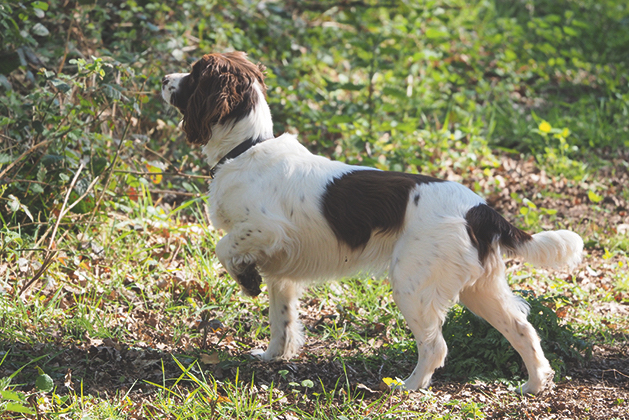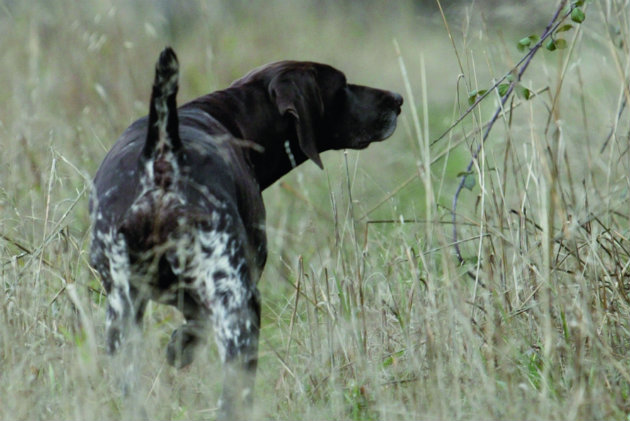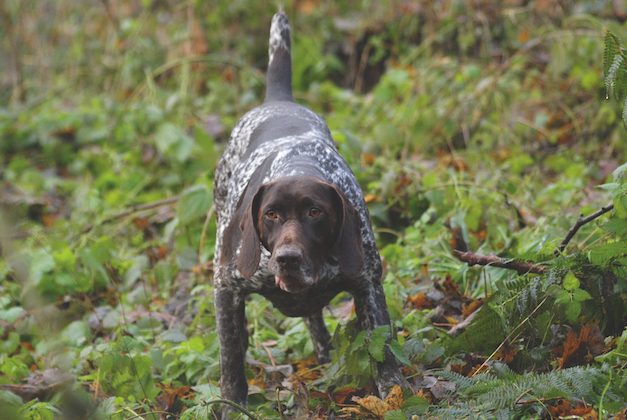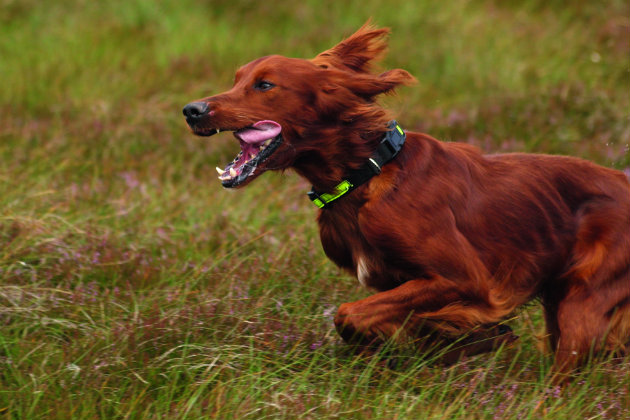Win CENS ProFlex DX5 earplugs worth £1,149 – enter here
Why do dogs point?
 Emma pointing a squirrel
Emma pointing a squirrel
Pointing is one of the most fascinating of dog behaviours and one that was recognised long ago as a useful trait to encourage in hunting dogs.
Today, there’s a misconception that only pointers, setters and the continental HPR breeds point, but any breed of gundog will point, though it’s unusual for retrievers or spaniels to do so. There’s a logical reason for this, as pointing is a behaviour that spaniels or retrievers have never been selectively bred for. In contrast, all the pointing breeds have been carefully bred to encourage pointing; in the past, individuals that didn’t point would have been put down.
I once had an English springer that pointed, though a better description would be that she indicated game. She was a great rough-shooting dog — if you were hunting a hedgerow with her, you would always know if she was on to game, as she would pause momentarily, indicating its presence, before flushing it. She never held a point for more than a few seconds, but it was long enough to slip the safety catch and prepare for a shot. Alas, it wasn’t a behaviour that she passed on to her offspring.

HPRs will stop dead and go on point when they wind any game
I once discussed her pointing with a spaniel trialler who had far more experience of springers than me. He told me that it wasn’t that unusual to have a spaniel that indicated game, but triallers didn’t want dogs that did this, as judges would mark down dogs that paused before flushing. Thus few, if any, successful trialling spaniels will have a tendency to point, as such behaviour has been largely bred out.
If you look across the Channel, you will find the French spaniel, epagneul Français, which looks very much like a large liver-and-white English springer. I’ve seen individuals that looked so similar to a springer you would be hard-pushed to tell them apart. There seems little doubt that the French spaniel and the English springer share common ancestry, but the former has been bred to point, the latter hasn’t. All the French gundog breeds point, as this suits the way the French like to shoot.
In theory, it would be possible to breed a pointing springer by selectively breeding from any individual that showed a tendency to point, discarding any that didn’t. Quite how many generations it would take is debatable. However, if you will excuse the pun, such a programme would be pointless: why not just get a French spaniel in the first place?

German shorthaired pointer on point
Why do dogs point?
I’ve only seen wild wolves once, but I’ve never seen a pack hunting. According to what I have been told, when wolves first scent their quarry, the leading members of the pack freeze and point rigidly in its direction.
The other members of the pack do likewise, striving to scent the animal or bird. Once they are all on the scent, the hunt resumes.
Thus, pointing is an entirely natural behaviour, one that the early breeders of hunting dogs capitalised upon. It was particularly useful when hunters depended on nets rather than guns, but was equally effective with muzzle-loading shotguns.
Setters were bred to set their game, which meant they were expected to drop when they scented quarry. This was useful as the net could be thrown over both the dogs and the birds.

Watching pointers and setters quartering a moor, covering the ground with ease and elegance, is always a joy
Classic stance
The word setter is simply a derivative of sitter. Some setters will still drop when they scent birds, but most will lock on to the birds with the classic pointing stance, with one paw raised, head and neck lowered, and eyes fixed on where the invisible birds are crouched. The tail is usually held stiffly in a horizontal position. A slight quivering of the tail indicates the dog’s tension.
Many pointing dogs hold a point for many minutes, as long as the quarry sits tight and doesn’t move. It’s easy to lose a dog if it is locked on point out of sight on moorland or dense woodland, as a pointing dog is usually deaf to the whistle. I remember once, when hawking in Sutherland, an anxious search for a German shorthaired pointer. We found the dog after 20 minutes — it seemed much longer — locked on point in a piece of dead ground.
These days, bleeping collars can be used to tell the handler when a dog is on point, while some collars also have a GPS location system. It’s a matter of marrying the most primitive of hunting instincts with the latest in technology.
I once met an Irish water spaniel enthusiast whose rough shooting dogs were passable pointers. He believed the IWS was the nearest thing we have in the British Isles to an HPR. I don’t know how many of these spaniels will point if given the opportunity, but I’m sure that there’s a fair amount of pointing blood in their ancestry, making such behaviour understandable.
This article was prompted by my sprocker, Emma, pointing a squirrel on a recent walk. Her point, shown in my photograph (main image), was hardly a classic, but a good effort. If you have a non-pointing breed that points I’d be fascinated to hear from you.
Related Articles
Get the latest news delivered direct to your door
Subscribe to Shooting Times & Country
Discover the ultimate companion for field sports enthusiasts with Shooting Times & Country Magazine, the UK’s leading weekly publication that has been at the forefront of shooting culture since 1882. Subscribers gain access to expert tips, comprehensive gear reviews, seasonal advice and a vibrant community of like-minded shooters.
Save on shop price when you subscribe with weekly issues featuring in-depth articles on gundog training, exclusive member offers and access to the digital back issue library. A Shooting Times & Country subscription is more than a magazine, don’t just read about the countryside; immerse yourself in its most authoritative and engaging publication.







